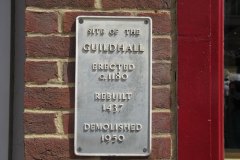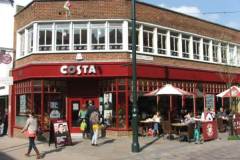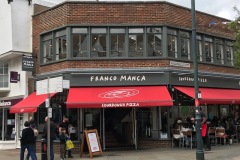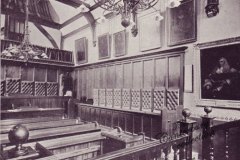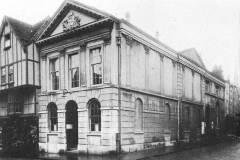Corner of High Street & Guildhall Street
Only the plaque (Image 1) commemorates the site of the ancient building that used to stand at this imposing location. It was recently occupied by a coffee shop (Image 2) but now serves pizza (Image 2a).
The Canterbury Guildhall stood on this site for 770 years, the location of local government and local justice. It was also used for music concerts – the young Mozart (almost certainly) played here in 1765. It was rebuilt or refurbished on a number of occasions, 1437, 1688, 1697, and 1835. The picture (Image 3) shows the imposing frontage on to the High Street that was added in 1835, the matching frontage on to Guildhall Street was added in the early 20th century.
Demolition of the building in 1950 became the centre of a heated controversy. In 1948 the architect Hugh Wilson reported to the City Council on the building’s condition. He said that there was dry rot in the roof, which was in danger of collapse and the flint walls quickly disintegrated into loose stone and dust when gently probed. Part of the poor state of the building was due to poor workmanship over the past centuries.. The Council agreed to progressive dismantling of the building from 1949. Initially this was from a point of view of making repairs, but it soon became evident that the building would have had to be rebuilt from the ground up. Eventually after much consultation the decision was taken to demolish the building. This decision has proved controversial because although the cost of rebuilding was estimated in 1950 to be about £18,000, if this money was spent could the resulting building be considered to be original, and if so to what use could it be put? The Magistrates had already decided that the facilities within it were quite unsuitable for modern justice, being cramped and inadequate and refused point blank to use it again. There was no obvious usefulness for such a building and the final design was likely to be of little resemblance to the original. The decision to demolish was clearly difficult and the Kentish Gazette said “The decision to demolish the building was made and carried out with unseemly haste and represents the sacrifice of an object of great antiquity on the altar of modernity.”
John Boyle who was the Canterbury town clerk from 1942 to 1972 has said in his book “All old buildings can be preserved, but no one can build an old building, and the same goes for an old area. Do the critics think, perhaps that the new should masquerade as the old? If so they will run into the equally vocal body of counter criticism that sarcastically denounces reproduction architecture.”
Sources: www.machadoink.com; Boyle (2009); Crampton (1991); Crampton (2006); regarding Mozart see Kentish Post 20 July 1765.
KW

